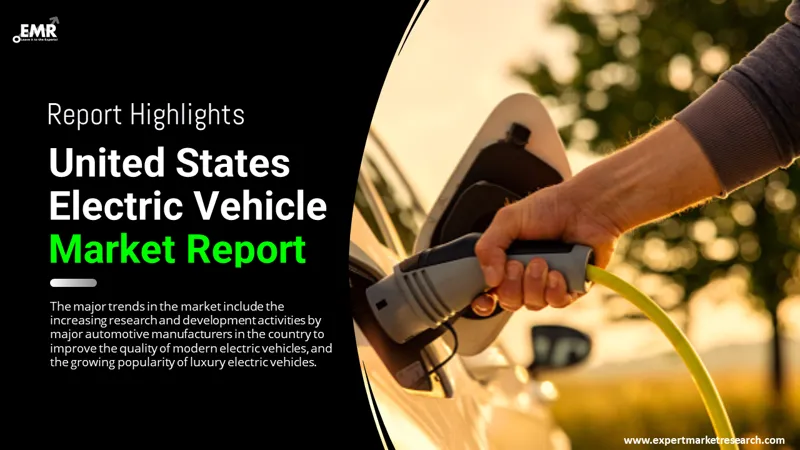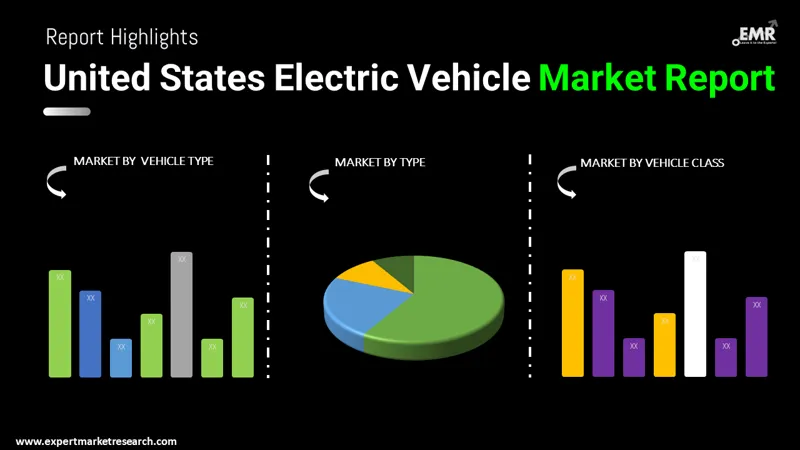
Consumer Insights
Uncover trends and behaviors shaping consumer choices today
Procurement Insights
Optimize your sourcing strategy with key market data
Industry Stats
Stay ahead with the latest trends and market analysis.
The United States electric vehicle market would likely grow at a CAGR of 24.60% during 2026-2035.
Base Year
Historical Period
Forecast Period
Compound Annual Growth Rate
24.6%
2026-2035
*this image is indicative*
Electric vehicles comprise a relatively small portion of the total automotive market. However, electric vehicles are becoming increasingly popular with growing range, style and performance of modern electric vehicles. This growing popularity is expected to boost the United States electric vehicle market. Automakers are striving to make recharging easier and quicker. Customers seeking zero-emission driving have more options to choose from, with a broader variety of body styles and many price points.

Read more about this report - REQUEST FREE SAMPLE COPY IN PDF
Popular electric vehicle brands in the US include GMC Hummer EV — 47 MPGe, Rivian R1S — 69 MPGe, Rivian R1T — 70 MPGe, Porsche Taycan Cross Turismo — 76 MPGe, Jaguar I-Pace — 76 MPGe, Audi e-tron Sportback — 77 MPGe, Audi e-tron — 78 MPGe, Porsche Taycan — 79 MPGe, Audi e-tron GT — 82 MPGe, Volvo XC40 Recharge — 85 MPGe, Volvo C40 Recharge — 87 MPGe, Mazda MX-30 — 92 MPGe, Mercedes EQS — 97 MPGe, Volkswagen ID.4 — 99 MPGe, Ford Mustang Mach-E — 101 MPGe, Tesla Model X — 102 MPGe, Polestar 2 — 107 MPGe, Mini Cooper SE Electric — 110 MPGe, Nissan Leaf — 111 MPGe, Kia Niro EV — 112 MPGe, Hyundai Ioniq 5 — 114 MPGe, Chevrolet Bolt EUV — 115 MPGe, Kia EV6 — 117 MPGe, Chevrolet Bolt EV — 120 MPGe (tie), Hyundai Kona Electric — 120 MPGe (tie), Tesla Model S — 120 MPGe (tie), Tesla Model Y — 122 MPGe, and Lucid Air — 131 MPGe. These offerings are expected to drive the United States electric vehicle market.
The Inflation Reduction Act (IRA) is an important climate legislation in the US. IRA’s investments in climate and clean energy could significantly decrease U.S. greenhouse gas (GHG) emissions.
Transportation is the nation’s biggest source of GHG emissions, and electric vehicles are considered the quickest way to reverse that trend.
IRA seeks to lay the foundation for a more equitable, sustainable, and secure transportation future. Investments in a diverse international electric vehicle supply chain would expectedly decrease battery costs and promote clean transportation.

Read more about this report - REQUEST FREE SAMPLE COPY IN PDF
United States Electric Vehicle Market Report and Forecast 2026-2035 offers a detailed analysis of the market based on the following segments:
Market Breakup by Type
Market Breakup by Vehicle Class
Market Breakup by Vehicle Type
Market Breakup by Region
The report offers an extensive assessment of major players in the US electric vehicle market; it evaluates their capability, observes latest occurrences such as mergers and acquisitions, capacity expansions, and plant turnarounds:
Using SWOT analysis and Porter’s Five Forces model, the EMR report offers deep insights into the industry.
Australia Electric Vehicle Market
Singapore Electric Vehicle Market
United Kingdom Electric Vehicle Market




*While we strive to always give you current and accurate information, the numbers depicted on the website are indicative and may differ from the actual numbers in the main report. At Expert Market Research, we aim to bring you the latest insights and trends in the market. Using our analyses and forecasts, stakeholders can understand the market dynamics, navigate challenges, and capitalize on opportunities to make data-driven strategic decisions.*
Get in touch with us for a customized solution tailored to your unique requirements and save upto 35%!
The market is estimated to grow at a CAGR of 24.60% in the forecast period of between 2026 and 2035.
The major drivers of the market include the rapid transition towards cleaner powered transportation systems, growing awareness pertaining to the eco-friendly properties of electric vehicles, and increasing spending of car owners towards maintenance of traditional cars.
The growing research and development activities by the major automotive manufacturers in the country aimed towards improving the quality of the modern EVs and rising popularity of luxury electric vehicles, are the key trends in the market.
BEV, PHEV, and FCEV are the various types of electric vehicles in the market.
Mid-priced and luxury are the different vehicle class categories available in the market.
The major players in the United States electric vehicle market are Tesla, Inc, FCA Italy S.p.A (Fiat), BMW AG, Volkswagen Group, Hyundai Motor Company, AB Volvo, Mercedes-Benz Group AG, Ford Motor Company, Toyota Motor Corporation, General Motors, and Renault-Nissan-Mitsubishi, among others.
The cost to charge the battery of an electric vehicle may range from USD 15 to 30.
Yes, electric vehicles can be fully air conditioned.
Explore our key highlights of the report and gain a concise overview of key findings, trends, and actionable insights that will empower your strategic decisions.
| REPORT FEATURES | DETAILS |
| Base Year | 2025 |
| Historical Period | 2019-2025 |
| Forecast Period | 2026-2035 |
| Scope of the Report |
Historical and Forecast Trends, Industry Drivers and Constraints, Historical and Forecast Market Analysis by Segment:
|
| Breakup by Type |
|
| Breakup by Vehicle Class |
|
| Breakup by Vehicle Type |
|
| Breakup by Region |
|
| Market Dynamics |
|
| Competitive Landscape |
|
| Companies Covered |
|
Datasheet
One User
USD 2,499
USD 2,249
tax inclusive*
Single User License
One User
USD 3,999
USD 3,599
tax inclusive*
Five User License
Five User
USD 4,999
USD 4,249
tax inclusive*
Corporate License
Unlimited Users
USD 5,999
USD 5,099
tax inclusive*
*Please note that the prices mentioned below are starting prices for each bundle type. Kindly contact our team for further details.*
Flash Bundle
Small Business Bundle
Growth Bundle
Enterprise Bundle
*Please note that the prices mentioned below are starting prices for each bundle type. Kindly contact our team for further details.*
Flash Bundle
Number of Reports: 3
20%
tax inclusive*
Small Business Bundle
Number of Reports: 5
25%
tax inclusive*
Growth Bundle
Number of Reports: 8
30%
tax inclusive*
Enterprise Bundle
Number of Reports: 10
35%
tax inclusive*
How To Order

Select License Type
Choose the right license for your needs and access rights.

Click on ‘Buy Now’
Add the report to your cart with one click and proceed to register.

Select Mode of Payment
Choose a payment option for a secure checkout. You will be redirected accordingly.
Gain insights to stay ahead and seize opportunities.

Get insights & trends for a competitive edge.

Track prices with detailed trend reports.

Analyse trade data for supply chain insights.

Leverage cost reports for smart savings

Enhance supply chain with partnerships.

Connect For More Information
Our expert team of analysts will offer full support and resolve any queries regarding the report, before and after the purchase.
Our expert team of analysts will offer full support and resolve any queries regarding the report, before and after the purchase.
We employ meticulous research methods, blending advanced analytics and expert insights to deliver accurate, actionable industry intelligence, staying ahead of competitors.
Our skilled analysts offer unparalleled competitive advantage with detailed insights on current and emerging markets, ensuring your strategic edge.
We offer an in-depth yet simplified presentation of industry insights and analysis to meet your specific requirements effectively.
Share